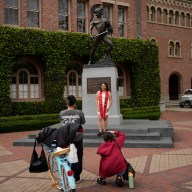Some of Stephen King‘s
best books do double duty as doorstops and “11/22/63” is no exception.
At
849 pages, it may appeal more to the Kindle crowd, but just try to read
the first sentence (“I have never been what you’d call a crying man.”)
and not turn the page.
The title is the date President John F.
Kennedy was shot and killed in Dallas. The plot of the book is pretty
straightforward at first. What if you could go back in time and change
history? If JFK survives, how do the next 48 years unfold?
“11/22/63”
begins in 2011 and is narrated by Jake Epping, a high school English
teacher from Lisbon Falls, Maine. He likes his small-town job, but his
marriage has ended and left a hole behind.
Enter Al Templeton, the
owner of a local diner whose specialty – the Fatburger – sells for just
$1.19. The rock-bottom price has always been a mystery to the citizens
of Lisbon Falls, but it’s soon solved by Jake. Al’s been walking through a door in the back of his pantry into 1958, where he buys ground beef for pennies.
But besides basking
in those profits, what he really wants to do is save President Kennedy
from assassination. The door always opens on Sept. 9, 1958, and no
matter how long someone spends in the past, only two minutes go by in
the present. Al has done his research. He knows all about Lee Harvey
Oswald and his communist friends, and most of the moves he made leading
up to that fateful day. He just couldn’t finish the job because the
cancer eating his lungs required more care than medicine could provide
four decades ago.
The book is a delightful blend of history and
fantasy. The man whose imagination gave us a pet cemetery that drives
people insane and a devil incarnate named Randall Flagg has always had
a soft spot for an America where men wore fedoras, drove Fords with big
engines and everyone could do the fox trot.
King‘s
eye for period detail is sharp. Dig this description of the DJ at the
high school dance: “He wore pink-rimmed specs with thick lenses,
belt-in-the-back slacks, and saddle shoes so grotesquely square they
were authentically crazy, man. His face was an exploding zit-factory
below a Brylcreem-loaded Bobby Rydell” haircut.
Fans will love the echoes of other Stephen King
books. Part of it is set in the very bad place of Derry, Maine, after
the plot of “It.” The horror is vivid and imaginable. The supernatural
is limited to time travel and the villains are real – child killers and
wife beaters and one sandy-haired Marxist with a “cocky, sideways grin”
who did the unthinkable.
It’s a thriller until the climax, but King‘s
genius as a writer lies in passages where he peers behind life’s
curtain just long enough to make readers think before they anxiously
turn the page:
“For a moment everything was clear, and when that
happens you see that the world is barely there at all. Don’t we all
secretly know this? It’s a perfectly balanced mechanism of shouts and
echoes pretending to be wheels and cogs, a dreamclock chiming beneath a
mystery-glass we call life. Behind it? Below it and around it? … Men
with hammers, men with knives, men with guns. … A universe of horror
and loss surrounding a single lighted stage where mortals dance in
defiance of the dark.”
















